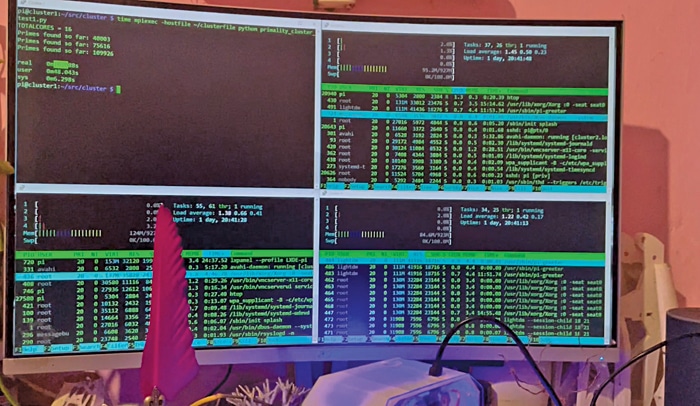Development Of China's Space-Based Supercomputer: Progress And Potential

Table of Contents
Current Status of China's Space-Based Computing Initiatives
Existing Spaceborne Computing Capabilities
China possesses a growing constellation of satellites capable of some level of on-board data processing. However, these capabilities are currently limited compared to the ambition of a full-fledged space-based supercomputer. Existing satellites primarily focus on specific tasks, such as Earth observation and communication relay, with limited computational power dedicated to on-board processing. Data is often transmitted back to Earth for extensive analysis, a process that is both time-consuming and bandwidth-intensive.
- Gaofen series: These Earth observation satellites possess some on-board processing capabilities for image enhancement and preliminary data analysis. However, complex algorithms and large-scale data processing are still performed on the ground.
- Tianlian series: These communication satellites handle data relay, but their computational resources are primarily focused on maintaining communication links, not intensive data processing.
Limitations in current spaceborne computing include:
- Processing Speed: Current on-board processors are significantly slower than high-performance computing systems found on Earth.
- Power Consumption: Power is a precious commodity in space, limiting the computational power achievable with current technology.
- Data Transmission: Transferring large datasets from space to Earth is a significant bottleneck, slowing down the overall data analysis process.
Technological Hurdles and Challenges
Developing a space-based supercomputer presents formidable engineering challenges. The harsh environment of space demands extreme resilience and reliability.
- Radiation Hardening: Space radiation can damage electronic components, requiring specialized radiation-hardened designs that are significantly more expensive and complex to manufacture.
- Miniaturization: A space-based supercomputer requires miniaturization of components to reduce weight and volume, while simultaneously maintaining high performance.
- Power Supply: Providing sufficient power for a high-performance computing system in space necessitates efficient and reliable power sources.
- Thermal Management: Dissipating heat generated by powerful processors in the vacuum of space presents significant thermal management challenges.
- Data Transmission Bandwidth: High-bandwidth communication links are crucial for transferring the vast amounts of data generated by a space-based supercomputer. Current technology limits the speed and capacity of these links.
Potential Applications of a Space-Based Supercomputer
Earth Observation and Environmental Monitoring
A space-based supercomputer could revolutionize Earth observation by enabling real-time processing of massive datasets from various sensors. This would provide:
- Real-time weather forecasting: More accurate and timely predictions of extreme weather events, improving disaster preparedness.
- Climate change monitoring: Continuous and comprehensive monitoring of climate change indicators, allowing for better understanding and mitigation strategies.
- Resource management: Improved monitoring of natural resources like forests and water supplies, facilitating more sustainable practices.
- Pollution detection and monitoring: Real-time analysis of pollution levels, enabling faster responses to environmental hazards.
Advancements in Astronomy and Astrophysics
The speed and power of a space-based supercomputer would be transformative for astronomy and astrophysics, allowing for:
- Real-time analysis of astronomical data: Faster processing of data from space telescopes, enabling quicker discoveries and a deeper understanding of the universe.
- Detection of gravitational waves: Improved sensitivity in detecting gravitational waves, providing further insights into the universe's most energetic events.
- Discovery of exoplanets: Faster analysis of data could lead to the discovery of more exoplanets and potentially habitable worlds.
National Security and Defense Applications
While ethical considerations are paramount, the potential military applications of a space-based supercomputer are undeniable. This includes:
- Enhanced satellite imagery analysis: Real-time processing of high-resolution satellite images for improved intelligence gathering and threat assessment.
- Secure communication networks: A space-based supercomputer could provide a more secure and resilient communication network for military operations.
- Improved surveillance capabilities: Enhanced surveillance systems for monitoring critical infrastructure and detecting potential threats.
International Collaboration and Competition
China's Position in the Global Space Race
China is rapidly advancing its space capabilities, investing heavily in research and development of space-based technologies. While still behind the US in some areas, China is making significant strides in satellite technology and high-performance computing.
- Technological Advancements: China is actively developing advanced satellite platforms and pursuing breakthroughs in quantum computing, which could potentially be integrated into a space-based supercomputer.
- Funding Levels: Significant government funding is fueling China's space program, enabling ambitious projects like the development of a space-based supercomputer.
- Strategic Goals: China aims to become a global leader in space technology, and a space-based supercomputer would be a major step towards achieving this goal.
Potential for International Partnerships
International collaboration could accelerate the development of space-based supercomputers. However, challenges remain:
- Shared Resources and Expertise: Collaboration would pool resources and expertise, speeding up development and reducing costs.
- Intellectual Property Rights: Protecting intellectual property rights is crucial for encouraging international collaboration.
- National Security Concerns: Concerns about the potential misuse of space-based technology could hinder international cooperation.
Conclusion
The development of China's space-based supercomputer is a complex undertaking fraught with technological challenges. However, the potential benefits across Earth observation, astronomy, and national security are immense. While hurdles remain, the pursuit of this ambitious goal highlights China's commitment to advancing its space program and securing a leading role in the global technological landscape. Follow the development of China's space-based supercomputer for updates on this groundbreaking technology and its implications for the future. Stay tuned for further articles exploring the specifics of China's advancements in spaceborne high-performance computing.

Featured Posts
-
 March 26 2025 Nyt Mini Crossword Complete Answers And Hints
May 21, 2025
March 26 2025 Nyt Mini Crossword Complete Answers And Hints
May 21, 2025 -
 Peppa Pigs Mum Reveals The Gender Of The New Piglet
May 21, 2025
Peppa Pigs Mum Reveals The Gender Of The New Piglet
May 21, 2025 -
 Securities Lawsuit Targets Big Bear Ai Details Of The Legal Action
May 21, 2025
Securities Lawsuit Targets Big Bear Ai Details Of The Legal Action
May 21, 2025 -
 Irish Actor Barry Ward A Candid Interview On Roles And Casting
May 21, 2025
Irish Actor Barry Ward A Candid Interview On Roles And Casting
May 21, 2025 -
 Analyzing The Friday Increase In D Wave Quantum Inc Qbts Stock Value
May 21, 2025
Analyzing The Friday Increase In D Wave Quantum Inc Qbts Stock Value
May 21, 2025
Latest Posts
-
 Goretzka Selected For Nations League By Nagelsmann
May 21, 2025
Goretzka Selected For Nations League By Nagelsmann
May 21, 2025 -
 Nagelsmann Names Goretzka For Nations League
May 21, 2025
Nagelsmann Names Goretzka For Nations League
May 21, 2025 -
 Goretzkas Nations League Call Up Nagelsmanns Germany Squad Announcement 03 13 2025
May 21, 2025
Goretzkas Nations League Call Up Nagelsmanns Germany Squad Announcement 03 13 2025
May 21, 2025 -
 Nagelsmann Names Goretzka For Germanys Nations League Team
May 21, 2025
Nagelsmann Names Goretzka For Germanys Nations League Team
May 21, 2025 -
 Can Germany Overcome Italy In The Crucial World Cup Quarterfinal
May 21, 2025
Can Germany Overcome Italy In The Crucial World Cup Quarterfinal
May 21, 2025
